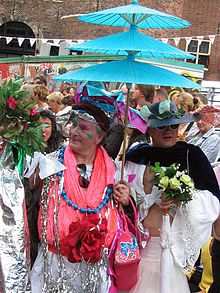Hartjesdag

The hartjesdag (dt. Herzentag ) is a holiday in the Netherlands on the third Monday in August and is in Haarlem , Bloemendaal and in Amsterdam , in particular around the Haarlemmerplein and in the districts of Jordaan and Dapperbuurt celebrated. In the center of Amsterdam on the Zeedijk and the Nieuwmarkt , the Hartjesdagen is an event lasting several days, the highlight of which is a parade of drag queens and drag kings .
Word origin
The origin of the word Hartjesdag is not clear. It was probably created in the Middle Ages and is a corruption of Hertjesdag (German deer day ). Allegedly, on this festival day, the simple rural population was allowed to hunt deer in the forests around Haarlem, which was normally reserved for the nobility. The hunted animals were roasted and eaten on the street.
According to another theory, the Hartjesdag was originally dedicated to the Germanic earth goddess Hertus. On Hartjesdag, which was at the end of the harvest season, the earth goddess is said to have been honored with bonfires. The Roman historian Tacitus already describes such harvest celebrations in honor of the earth goddess Hertus. A wooden temple on the bank of the Spaarne on the site of today's Haarlem is said to have been dedicated to her.
history
Fires were kindled on Hartjesdag and children raised money for fireworks, which were set off in the evening. This later developed into a kind of carnival where people sang, danced and drank a lot in the streets. Men dressed up as women and women as men. This festival was also celebrated around the Zeedijk in Amsterdam. Hartjesdag sometimes got out of hand, especially in the evenings. Every year in the 19th century there were reports of "terrible drunkenness and unbridled debauchery" in the Jordaan and Haarlemmerdijkbuurt neighborhoods. Johan Braakensiek (1858–1940) made a print in 1895 and an oil painting in 1926 with the theme of the festival.
In 1943 the Hartjesdag was banned by the German occupiers. After the war, the festival was forgotten.
In 1997, the Zeedijk neighborhood association decided to revive the holiday. Since then, the most original costumes by men in women's clothing and women in men's clothing have been awarded. Over the years the event was extended to several days, which became popular as the Hartjesdagen (German heart days ). In particular, the Hartjesparade , a parade of drag queens , drag kings and other costumed men and women, now attracted tens of thousands of people every year.
Web links
- Hartjesdag on the website of the City Archives Amsterdam
- Hartjesdagen Zeedijk on the website stichtinghartjesdagen.nl
